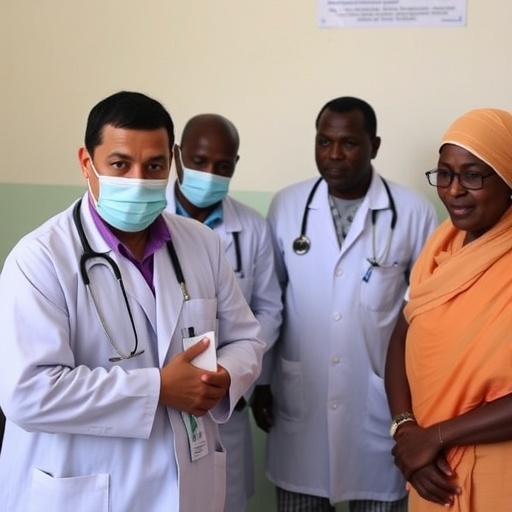In a world increasingly reliant on effective veterinary practices for public health and the management of livestock populations, the emerging careers of new veterinary graduates remain a pivotal focus. Recent research conducted by Mohammed et al. delves into the perceived competency gaps and training needs of these recent graduates in Sudan, offering critical insights into their preparedness for the field. This study underscores the growing necessity for a comprehensive review of veterinary education systems worldwide, particularly in developing nations where the stakes are high.
The landscape of veterinary education faces significant challenges, especially in regions like Sudan, where resources can be scarce and training opportunities limited. Graduates entering the field must navigate a complex environment where their roles extend beyond traditional animal care to encompass broader public health concerns. As these new veterinarians step into their roles, they often encounter overwhelming expectations that highlight a disparity between their training and the realities of clinical practice. Identifying these competency gaps is crucial for enhancing educational programs and supporting graduates in their transition to professional life.
This study emphasizes the necessity of aligning veterinary education with the evolving requirements of the profession. It takes a closer look at the specific areas where graduates feel they lack confidence and competence. Throughout the research, participants expressed concerns regarding their clinical skills, application of theoretical knowledge, and overall readiness for real-world challenges. This perception of inadequacy not only impacts their self-esteem as professionals but could also compromise animal welfare and public health outcomes.
By adopting a mixed-methods approach, the study highlights qualitative insights drawn from interviews with practitioners and quantitative data from surveys. This comprehensive analysis provides a detailed understanding of the complexities faced by new graduates. The findings reveal that many recent veterinarians in Sudan feel ill-equipped to handle various aspects of their roles, including disease control, veterinary epidemiology, and animal health management. These experiences underscore a vital need for educational reform that addresses both theoretical and practical training.
As the study reveals, addressing the identified gaps in veterinary education must be a collaborative endeavor. Engaging stakeholders, including educational institutions, governmental bodies, and veterinary associations, is essential for developing targeted strategies that enhance the training of future veterinarians. By fostering a multidisciplinary approach, stakeholders can create curricula that emphasize critical thinking, problem-solving skills, and real-world applications. This integration of theory and practice is instrumental in preparing graduates for the multifaceted demands of their profession.
Another important aspect explored by Mohammed et al. is the role of mentorship in bridging competency gaps. Establishing mentorship programs that connect seasoned veterinarians with new graduates can provide invaluable support and guidance. Mentorship can facilitate knowledge transfer, offering practical insights that classroom settings often can’t provide. Creating a structured system for mentorship within veterinary education could lead to improved confidence and capability among new practitioners.
The significance of continuous professional development (CPD) is also underscored in the study. To stay relevant in an ever-evolving field, veterinarians must engage in lifelong learning. Institutions and professional organizations should provide access to CPD opportunities that are tailored to meet the specific needs of new graduates. Workshops, seminars, and online courses focused on emerging challenges in veterinary practice can bridge the knowledge gap and enhance skills in areas such as ethical decision-making and advanced diagnostics.
Moreover, the findings call for an increased emphasis on soft skills as part of veterinary education. Effective communication, teamwork, and empathy are critical competencies that contribute to a veterinarian’s success in practice. Graduates must be able to convey complex information to clients clearly and compassionately, fostering trust and collaboration. By incorporating soft skills training into the curriculum, educational institutions can prepare students not only for clinical tasks but also for building robust relationships with clients and communities.
In light of the challenges identified in the study, it is imperative to advocate for systemic changes in veterinary training programs. Policymakers and educational leaders must prioritize the development and implementation of curricula that are inclusive of both theoretical knowledge and practical skills. Ensuring that graduates are well-prepared to meet the demands of the profession is essential for the future of veterinary services, animal welfare, and public health.
As we analyze the implications of this research, it becomes clear that the quest for better-prepared veterinary graduates is a global concern. While this study specifically focuses on Sudan, the identified gaps and needs resonate with the experiences of many recent graduates worldwide. By learning from this research, different countries can assess their own educational frameworks and make necessary adjustments to protect the integrity of veterinary practice.
Ultimately, the study by Mohammed et al. is a call to action for educators, policymakers, and veterinary professionals alike. It highlights the necessity of fostering environments where continuous learning and adaptation are prioritized. As we move forward, addressing the perceived competency gaps and training needs of new veterinary graduates is more than just an educational issue; it is a commitment to safeguarding animal and public health for future generations.
Such an in-depth view of veterinary education provides a foundation for future research aimed at understanding how best to support new graduates as they embark on their careers. By establishing a more robust and relevant training program, the veterinary profession can not only enhance the skills of new practitioners but also improve outcomes for the animals and communities they serve.
Subject of Research: Competency gaps and training needs of new veterinary graduates in Sudan
Article Title: Perceived competency gaps and training needs of new veterinary graduates in Sudan: an in-depth view
Article References:
Mohammed, A., Nasir, I., Musa, A. et al. Perceived competency gaps and training needs of new veterinary graduates in Sudan: an in-depth view.
Discov Educ 4, 359 (2025). https://doi.org/10.1007/s44217-025-00826-7
Image Credits: AI Generated
DOI: https://doi.org/10.1007/s44217-025-00826-7
Keywords: Veterinary education, competency gaps, training needs, Sudan, continuous professional development, mentorship, soft skills.




